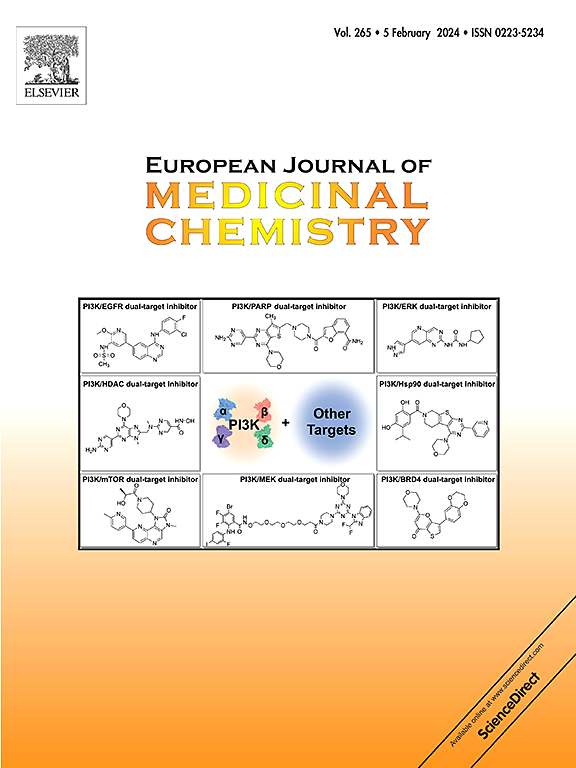Design and synthesis of Riluzole-Ciprofloxacin hybrids as selective MST3 inhibitors for cancer treatment
IF 6
2区 医学
Q1 CHEMISTRY, MEDICINAL
引用次数: 0
Abstract
The MST3 isozyme is integral to the modulation of cellular proliferation and apoptosis, with its dysregulation critically implicated in the tumorigenesis of high-grade neoplasms. Current investigations into MST3 inhibitors are in their initial stages, characterized by restricted structural diversity and suboptimal selectivity. Previous studies have shown that Riluzole and Ciprofloxacin have the potential to be repurposing into the tumor field. Notably, their hybridization may facilitate the formation of a continuous hydrogen bonding network between donor and acceptor moieties, thereby augmenting their applicability as novel kinase inhibitors. In this study, we designed and synthesized a series of Riluzole-Ciprofloxacin hybrids, subsequently identifying the lead compound LD-1 (GI50 = 683.1 nM in HepG2 cells) through an anti-proliferative screening process. Comprehensive kinase profiling and target inhibition assays revealed that LD-1 functions as a potent and selective inhibitor of MST3, exhibiting an IC50 value of 122.4 nM. Preliminary mechanistic studies indicated that LD-1 reduced the expression levels of cleaved caspase-3 and Bcl-2, resulted in inducing HepG2 cells apoptosis. Meanwhile, it decreased the expression level of cyclin B1 in a concentration-dependent manner, leading to cell cycle at the G2/M transition. The in vivo experiments demonstrated that LD-1 significantly suppressed tumor growth (TGI = 47.64 %) at a dosage of 40 mg/kg, coupled none obvious adverse reactions were observed. Collectively, LD-1, characterized by its novel structure, high potency, and selectivity as an MST3 inhibitor, showcases substantial potential for further investigation and therapeutic development.

利鲁唑-环丙沙星复合物作为肿瘤选择性MST3抑制剂的设计与合成
MST3同工酶对细胞增殖和凋亡的调节是不可或缺的,其失调与高级别肿瘤的发生有重要关系。目前对MST3抑制剂的研究还处于初级阶段,其特点是结构多样性有限,选择性欠佳。先前的研究表明利鲁唑和环丙沙星有可能被重新利用到肿瘤领域。值得注意的是,它们的杂交可能有助于在供体和受体之间形成连续的氢键网络,从而增强了它们作为新型激酶抑制剂的适用性。在本研究中,我们设计并合成了一系列利鲁唑-环丙沙星杂合体,并通过抗增殖筛选鉴定出先导化合物LD-1(在HepG2细胞中GI50 = 683.1 nM)。综合激酶谱分析和靶抑制实验表明,LD-1是一种有效的选择性MST3抑制剂,IC50值为122.4 nM。初步机制研究表明,LD-1可降低cleaved caspase-3和Bcl-2的表达水平,诱导HepG2细胞凋亡。同时,它以浓度依赖性的方式降低了cyclin B1的表达水平,导致细胞周期在G2/M过渡。体内实验表明,在剂量为40 mg/kg时,LD-1可显著抑制肿瘤生长(TGI = 47.64%),且未见明显不良反应。总之,LD-1以其新颖的结构、高效能和选择性作为MST3抑制剂,显示出进一步研究和治疗开发的巨大潜力。
本文章由计算机程序翻译,如有差异,请以英文原文为准。
求助全文
约1分钟内获得全文
求助全文
来源期刊
CiteScore
11.70
自引率
9.00%
发文量
863
审稿时长
29 days
期刊介绍:
The European Journal of Medicinal Chemistry is a global journal that publishes studies on all aspects of medicinal chemistry. It provides a medium for publication of original papers and also welcomes critical review papers.
A typical paper would report on the organic synthesis, characterization and pharmacological evaluation of compounds. Other topics of interest are drug design, QSAR, molecular modeling, drug-receptor interactions, molecular aspects of drug metabolism, prodrug synthesis and drug targeting. The journal expects manuscripts to present the rational for a study, provide insight into the design of compounds or understanding of mechanism, or clarify the targets.

 求助内容:
求助内容: 应助结果提醒方式:
应助结果提醒方式:


